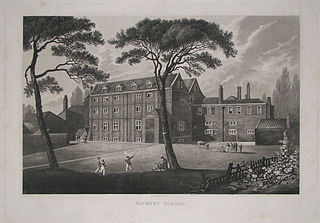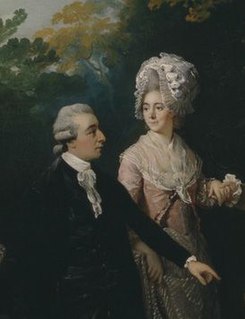Related Research Articles
The Keeper or Master of the Rolls and Records of the Chancery of England, known as the Master of the Rolls, is the second-most senior judge in England and Wales after the Lord Chief Justice, and serves as President of the Civil Division of the Court of Appeal and Head of Civil Justice. The position dates from at least 1286, although it is believed that the office probably existed earlier than that.
The British Critic: A New Review was a quarterly publication, established in 1793 as a conservative and high-church review journal riding the tide of British reaction against the French Revolution. The headquarters was in London. The journal ended publication in 1826.

Samuel Gurney was an English banker and philanthropist from the Gurney family of Norwich. He should not be confused with his second son, Samuel (1816–1882), also described as banker and philanthropist, and a Member of Parliament.

Justice of the Common Pleas was a puisne judicial position within the Court of Common Pleas of England and Wales, under the Chief Justice. The Common Pleas was the primary court of common law within England and Wales, dealing with "common" pleas. It was created out of the common law jurisdiction of the Exchequer of Pleas, with splits forming during the 1190s and the division becoming formal by the beginning of the 13th century. The court became a key part of the Westminster courts, along with the Exchequer of Pleas and the Court of King's Bench, but with the Writ of Quominus and the Statute of Westminster, both tried to extend their jurisdiction into the realm of common pleas. As a result, the courts jockeyed for power. In 1828 Henry Brougham, a Member of Parliament, complained in Parliament that as long as there were three courts unevenness was inevitable, saying that "It is not in the power of the courts, even if all were monopolies and other restrictions done away, to distribute business equally, as long as suitors are left free to choose their own tribunal", and that there would always be a favourite court, which would therefore attract the best lawyers and judges and entrench its position. The outcome was the Supreme Court of Judicature Act 1873, under which all the central courts were made part of a single Supreme Court of Judicature. Eventually the government created a High Court of Justice under Lord Coleridge by an Order in Council of 16 December 1880. At this point, the Common Pleas formally ceased to exist.
English county histories, in other words historical and topographical works concerned with individual ancient counties of England, were produced by antiquarians from the late 16th century onwards. The content was variable: some recorded archaeological sites, but others were heavily slanted towards the genealogies of county families and other biographical material, particularly relating to property and the descent of lordships of manors. The tradition continues with the series of Victoria County Histories.
Eastman's Royal Naval Academy, originally in Southsea and later at Winchester, both in England, was a preparatory school. Between 1855 and 1923 it was known primarily as a school that prepared boys for entry to the Royal Navy. Thereafter, it was renamed Eastman's Preparatory School and continued until the 1940s. According to Jonathan Betts, it was "considered one of the top schools for boys intended for the Navy".
Edward William Grinfield (1785–1864) was an English biblical scholar.

Newcome's School was a fashionable school in Hackney, then to the east of London, founded in the early 18th century. A number of prominent Whig families sent their children there. The school closed in 1815, and the buildings were gutted in 1820. In 1825 the London Orphan Asylum opened on the site. Today the Clapton Girls' Academy is located here.
Aulay Macaulay was a Scottish writer and clergyman of the Church of England.
Sir John Stonhouse, 3rd Baronet (c.1672–1733) was an English politician.
The Evangelical Magazine was a monthly magazine published in London from 1793 to 1904, and aimed at Calvinist Christians. It was supported by evangelical members of the Church of England, and by nonconformists with similar beliefs. Its editorial line included a strong interest in missionary work.

Charles Peter Layard, F.R.S., D.D. was Dean of Bristol from 1800 until his death.
References
- ↑ "Fellows of the Royal Society". London: Royal Society. Archived from the original on 2015-03-16.
- ↑ "Bosworth, Joseph (BSWT823J)". A Cambridge Alumni Database. University of Cambridge.
- ↑ "Cavendish, William (CVNS825W)". A Cambridge Alumni Database. University of Cambridge.
- ↑ "Henry Coddington". Oxford Dictionary of National Biography (online ed.). Oxford University Press. doi:10.1093/ref:odnb/5793.(Subscription or UK public library membership required.)
- ↑ Russel, K. F. (1961). "The Military General Service Medal Awarded to Bransby Cooper (1792–1853)". Medical History. 5 (3): 294. doi:10.1017/s0025727300026478. PMC 1034635

- ↑ "Alexander Crombie". Oxford Dictionary of National Biography (online ed.). Oxford University Press. doi:10.1093/ref:odnb/6747.(Subscription or UK public library membership required.)
- ↑ ES, Ridgway (1994). "John Elliotson (1791-1868): a bitter enemy of legitimate medicine? Part II: The mesmeric scandal and later years". Journal of Medical Biography. 2: 1–7. PMID 11615263.
- ↑ Agnew, R. (2013). "A memoir of Sir John Forbes (1787-1861)". Journal of Medical Biography. 22 (4): 190–194. doi:10.1177/0967772013504859. ISSN 0967-7720.
- ↑ "Lubbock, John William (LBK821JW)". A Cambridge Alumni Database. University of Cambridge.
- ↑ "Pollock, Siar David". Oxford Dictionary of National Biography (online ed.). Oxford University Press. doi:10.1093/ref:odnb/22477.(Subscription or UK public library membership required.)
- ↑ Candolle, Roger De; Radcliffe-Smith, Alan (1981). "Nathaniel Wallich, MD, PhD, FRS, FLS, FRGS, (1786-1854) and the Herbarium of the Honourable East India Company, and their relation to the de Candolles of Geneva and the Great Prodromus". Botanical Journal of the Linnean Society. 83 (4): 325–348. doi:10.1111/j.1095-8339.1981.tb00355.x. ISSN 0024-4074.